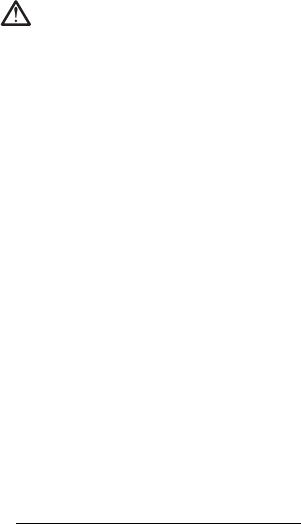
English
10
ResMed shall not be responsible for any incidental or consequential damages claimed to have resulted
from the sale, installation or use of any ResMed product. Some regions or states do not allow the
exclusion or limitation of incidental or consequential damages, so the above limitation may not apply to
you. This warranty gives you specific legal rights, and you may also have other rights which vary from
region to region. For further information on your warranty rights, contact your local ResMed dealer or
ResMed office.
WARNINGS
• Read the entire manual before using the device.
• Use the device only as directed by your physician or healthcare provider.
• Use the device only for the intended use as described in this manual. Advice contained in this
manual should not supersede instructions given by the prescribing physician.
• If you notice any unexplained changes in the performance of the device, if it is making unusual or
harsh sounds, if the device or the power supply are dropped or mishandled, if water is spilled into
the enclosure, or if the enclosure is broken, discontinue use and contact your ResMed Service
Center.
• Beware of electrocution. Do not immerse the device, humidifier, power supply or power cord in
water. In the event of a spill, disconnect the device from the power supply and let the parts dry.
Always unplug the device before cleaning and make sure that all parts are dry before plugging in the
device.
• Explosion hazard—do not use in the vicinity of flammable anesthetics.
• Make sure the power cord and plug are in good condition and the equipment is not damaged.
• Keep the power cord away from hot surfaces.
• The device should only be used with masks (and connectors
1
) recommended by ResMed, or by a
physician or respiratory therapist. A mask should not be used unless the device is turned on. Once
the mask is fitted, ensure that the device is blowing air. The vent hole or holes associated with the
mask should never be blocked.
Explanation: The device is intended to be used with special masks (or connectors) which have vent
holes to allow continuous flow of air out of the mask. When the device is turned on and functioning
properly, new air from the device flushes the exhaled air out through the mask vent holes. However,
when the device is not operating, insufficient fresh air will be provided through the mask, and the
exhaled air may be rebreathed. Rebreathing of exhaled air for longer than several minutes can, in
some circumstances, lead to suffocation. This applies to most models of CPAP or bilevel devices.
1. Ports may be incorporated into the mask or in connectors that are near the mask.
368874.book Page 10 Wednesday, October 3, 2012 8:37 AM















